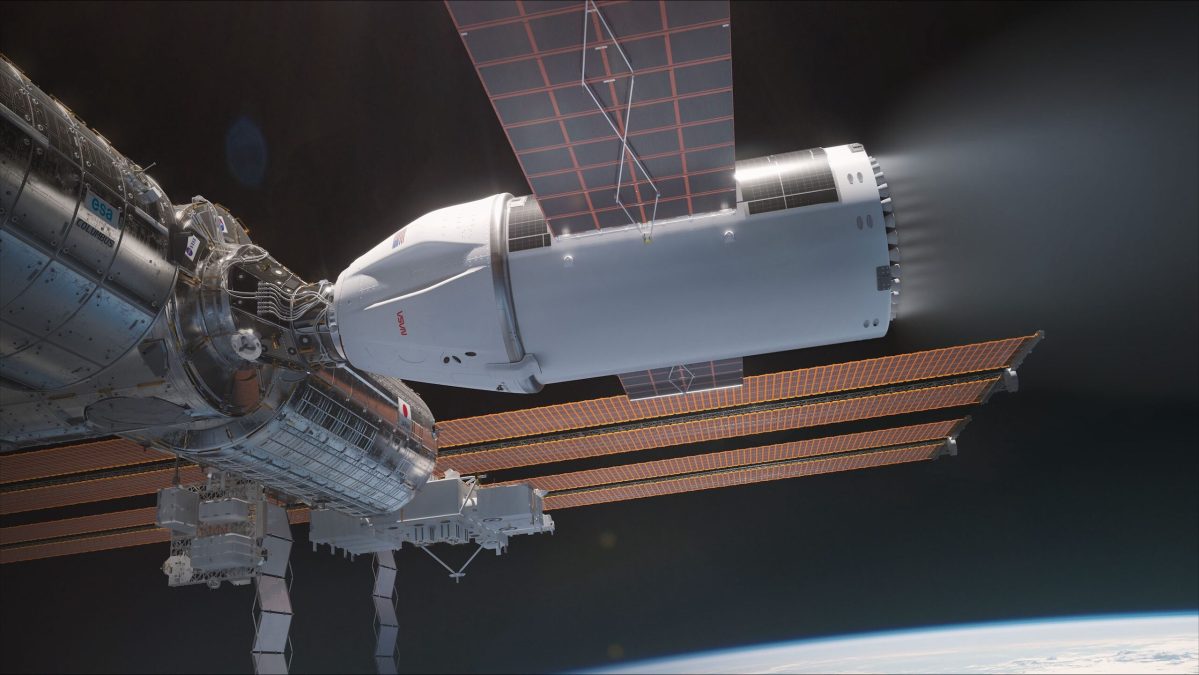BUSAN, South Korea — SpaceX will develop a souped-up version of its Dragon spacecraft for NASA to handle the deorbiting of the International Space Station around the end of the decade.
At a July 17 briefing, NASA and SpaceX officials provided new details about the United States Deorbit Vehicle (USDV) spacecraft NASA selected SpaceX to build June 26 under a contract worth up to $843 million. At the time of the announcement, neither the agency nor the company described the design of the spacecraft or its specific capabilities.
The USDV will be based on SpaceX’s Dragon spacecraft but with a redesigned, larger trunk section with more Draco thrusters. The spacecraft will have 46 Draco thrusters, 16 for attitude control and 30 to perform the maneuvers needed to lower the station’s orbit at the end of its life, said Sarah Walker, director of Dragon mission management at SpaceX.
The “enhanced” trunk section, she said, is twice as long as the regular one and will include engines, propellant tanks, power generation and other systems. It will store six times the propellant as the current Dragon spacecraft, while generating and storing three to four times the power. “It’s almost a spacecraft in and of itself,” she said.
NASA, which will own and operate the USDV after SpaceX builds it, will launch the vehicle to the ISS shortly after the arrival of the station’s final crew. Once the USDV arrives and is checked out, ISS controllers will allow the station’s orbit to naturally decay, with the final crew leaving once the station’s altitude, currently about 400 kilometers, reaches 330 kilometers.
The station’s orbit will decay further for about six months before NASA used the USDV for a final controlled deorbit of the station, targeting an open area of ocean in a narrow corridor about 2,000 kilometers long. Dana Weigel, NASA ISS program manager, said that NASA expects pieces of the station ranging in size from a microwave oven to a sedan to survive reentry and splash down in that corridor.
The USDV has an estimated mass of more than 30,000 kilograms, including 16,000 kilograms of propellant. “We’ve got to be on a heavier class of rocket,” Weigel said, rather than the Falcon 9 used for Dragon missions today. NASA will separately procure the launch vehicle at least three years before the launch.
“If the opportunity arises for SpaceX to launch the USDV, we’d happily support it,” Walker said.
The only other company to bid on the USDV was Northrop Grumman. According to NASA’s source selection statement, Northrop offered a vehicle with a price “significantly higher” than SpaceX with lower ratings on both mission suitability and past performance.
“I was really happy that we got proposals from the companies that we did,” said Ken Bowersox, NASA associate administrator for space operations. “I would have expected a few more, honestly, but I was very happy to get the ones that we got.”
Weigel added that NASA emphasized flight heritage in its request for proposals for the USDV because of the high reliability needed to safely bring down the station. “It doesn’t completely surprise me that our current transportation providers, who are already flying and compatible with things like docking to ISS” bid on the vehicle, she said. “I thought we would get a couple others, but definitely no surprise with the two we got.”
Falcon 9 anomaly update
The briefing took place nearly a week after a Falcon 9 suffered an anomaly during the launch of a set of Starlink satellites. A liquid oxygen leak in the rocket’s upper stage prevented that stage’s engine from performing a second burn, placing the satellites in orbits with very low perigees.
That incident grounded the Falcon 9, although Weigel said that, for now, NASA is moving ahead with plans to launch a Cygnus cargo vehicle as soon as early August on one Falcon 9 followed no earlier than mid-August by the Crew-9 launch on another Falcon 9.
SpaceX is investigating the anomaly in cooperation with the Federal Aviation Administration, which must give its approval that the vehicle does not pose any risks to public safety before SpaceX can resume launches. “We have our own process outside of what the FAA does,” Weigel said, noting that NASA is included in the ongoing investigation.
“We’re keeping a close partnership with the FAA and with all of our customers, and it’s going really well,” Walker said. “The team has made tremendous progress just in these first few days.”
She said the company was working to complete the investigation to see what impacts, if any, there will be to the schedule of the upcoming ISS and other launches. “This is our top company priority right now,” she said. “As for the Dragon team, my team, we continue to progress through our nominal launch preparations for a number of upcoming launches on our manifest.”
